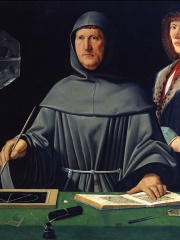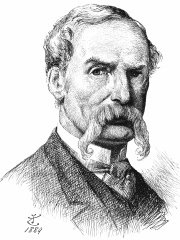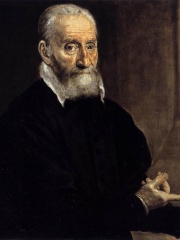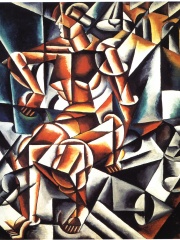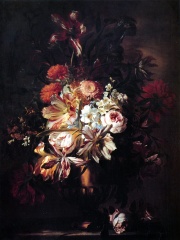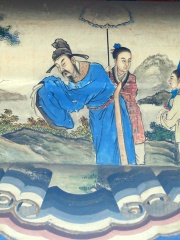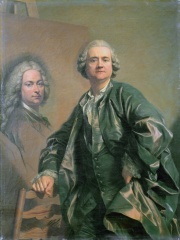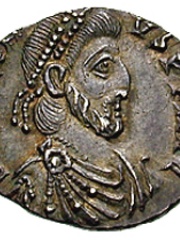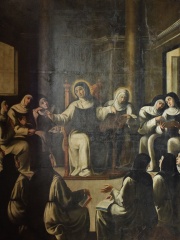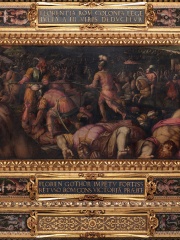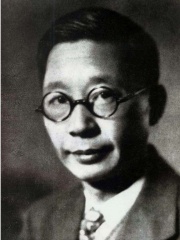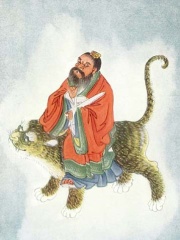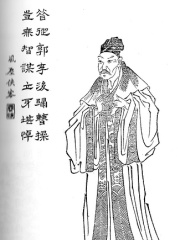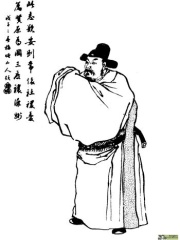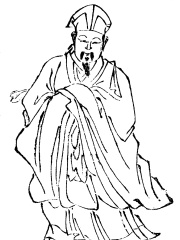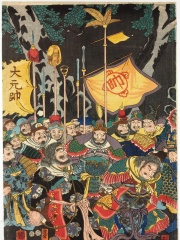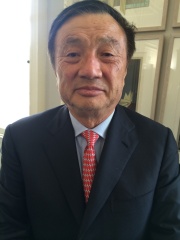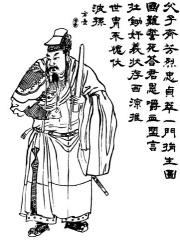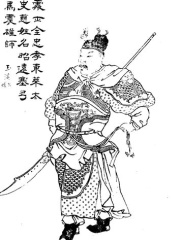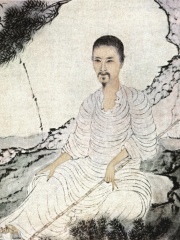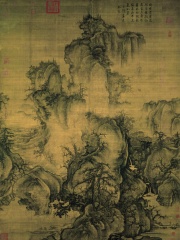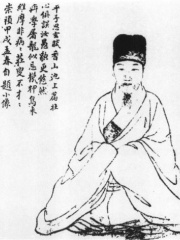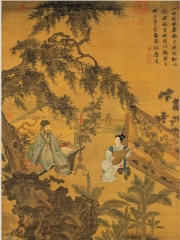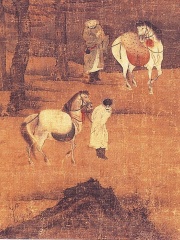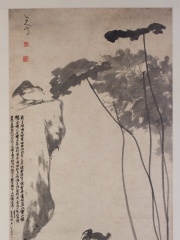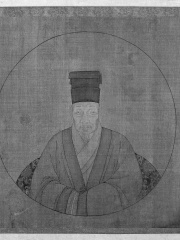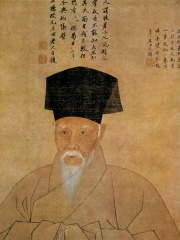PAINTER
Gu Kaizhi
345 - 406
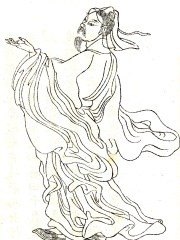
 Gu Kaizhi
Gu Kaizhi
Gu Kaizhi (simplified Chinese: 顾恺之; traditional Chinese: 顧愷之; pinyin: Gù Kǎizhī; Wade–Giles: Ku K'ai-chih; c. 344–406), courtesy name Changkang (長康), was a Chinese painter and politician during the Eastern Jin dynasty (317–420). He was a celebrated painter of ancient China. He was born in Wuxi and first painted at Nanjing in 364. Read more on Wikipedia
His biography is available in 27 different languages on Wikipedia. Gu Kaizhi is the 469th most popular painter (down from 459th in 2024), the 336th most popular biography from China (up from 356th in 2019) and the 2nd most popular Chinese Painter.
Memorability Metrics
Page views of Gu Kaizhi by language
Among PAINTERS
Among painters, Gu Kaizhi ranks 469 out of 2,023. Before him are Jacopo de' Barbari, Hans Makart, John Tenniel, Giulio Clovio, Lyubov Popova, and Abraham Brueghel. After him are Anna Boch, Mi Fu, Louis-Michel van Loo, Giovanni Lanfranco, Mariotto Albertinelli, and Richard Serra.
Most Popular Painters in Wikipedia
Go to all RankingsJacopo de' Barbari
1460 - 1516
HPI: 66.69
Rank: 463
Hans Makart
1840 - 1884
HPI: 66.69
Rank: 464
John Tenniel
1820 - 1914
HPI: 66.66
Rank: 465
Giulio Clovio
1498 - 1578
HPI: 66.62
Rank: 466
Lyubov Popova
1889 - 1924
HPI: 66.60
Rank: 467
Abraham Brueghel
1631 - 1690
HPI: 66.60
Rank: 468
Gu Kaizhi
345 - 406
HPI: 66.60
Rank: 469
Anna Boch
1848 - 1936
HPI: 66.59
Rank: 470
Mi Fu
1051 - 1107
HPI: 66.57
Rank: 471
Louis-Michel van Loo
1707 - 1771
HPI: 66.54
Rank: 472
Giovanni Lanfranco
1582 - 1647
HPI: 66.51
Rank: 473
Mariotto Albertinelli
1474 - 1515
HPI: 66.51
Rank: 474
Richard Serra
1939 - 2024
HPI: 66.51
Rank: 475
Contemporaries
Among people born in 345, Gu Kaizhi ranks 4. Before him are Jerome, Evagrius Ponticus, and Eugenius. After him are Tyrannius Rufinus, and Peter of Sebaste. Among people deceased in 406, Gu Kaizhi ranks 4. Before him are Godigisel, Paula of Rome, and Radagaisus.
Others Born in 345
Go to all RankingsJerome
RELIGIOUS FIGURE
345 - 420
HPI: 82.20
Rank: 1
Evagrius Ponticus
RELIGIOUS FIGURE
345 - 399
HPI: 70.54
Rank: 2
Eugenius
POLITICIAN
345 - 394
HPI: 68.55
Rank: 3
Gu Kaizhi
PAINTER
345 - 406
HPI: 66.60
Rank: 4
Tyrannius Rufinus
HISTORIAN
345 - 411
HPI: 66.16
Rank: 5
Peter of Sebaste
RELIGIOUS FIGURE
345 - 390
HPI: 62.47
Rank: 6
Others Deceased in 406
Go to all RankingsGodigisel
POLITICIAN
359 - 406
HPI: 67.60
Rank: 1
Paula of Rome
RELIGIOUS FIGURE
347 - 406
HPI: 67.00
Rank: 2
Radagaisus
POLITICIAN
400 - 406
HPI: 66.82
Rank: 3
Gu Kaizhi
PAINTER
345 - 406
HPI: 66.60
Rank: 4
In China
Among people born in China, Gu Kaizhi ranks 336 out of 1,610. Before him are Lao She (1899), Zhang Daoling (34), Ai Weiwei (1957), Jia Xu (147), He Jin (135), and Xun Yu (163). After him are Gao Shun (200), Mi Fu (1051), Ren Zhengfei (1944), Ma Teng (156), Ruzi Ying (5), and Taishi Ci (166).
Others born in China
Go to all RankingsLao She
WRITER
1899 - 1966
HPI: 66.65
Rank: 330
Zhang Daoling
PHILOSOPHER
34 - 156
HPI: 66.64
Rank: 331
Ai Weiwei
ARTIST
1957 - Present
HPI: 66.63
Rank: 332
Jia Xu
POLITICIAN
147 - 223
HPI: 66.63
Rank: 333
He Jin
MILITARY PERSONNEL
135 - 189
HPI: 66.61
Rank: 334
Xun Yu
POLITICIAN
163 - 212
HPI: 66.60
Rank: 335
Gu Kaizhi
PAINTER
345 - 406
HPI: 66.60
Rank: 336
Gao Shun
MILITARY PERSONNEL
200 - 199
HPI: 66.59
Rank: 337
Mi Fu
PAINTER
1051 - 1107
HPI: 66.57
Rank: 338
Ren Zhengfei
BUSINESSPERSON
1944 - Present
HPI: 66.56
Rank: 339
Ma Teng
POLITICIAN
156 - 212
HPI: 66.44
Rank: 340
Ruzi Ying
POLITICIAN
5 - 25
HPI: 66.44
Rank: 341
Taishi Ci
POLITICIAN
166 - 206
HPI: 66.43
Rank: 342
Among PAINTERS In China
Among painters born in China, Gu Kaizhi ranks 2. Before him are Shitao (1642). After him are Mi Fu (1051), Guo Xi (1020), Qi Baishi (1864), Han Gan (706), Dong Qichang (1555), Tang Yin (1470), Liang Kai (1200), Bada Shanren (1626), Wen Zhengming (1470), and Shen Zhou (1427).
Shitao
1642 - 1707
HPI: 69.32
Rank: 1
Gu Kaizhi
345 - 406
HPI: 66.60
Rank: 2
Mi Fu
1051 - 1107
HPI: 66.57
Rank: 3
Guo Xi
1020 - 1090
HPI: 66.28
Rank: 4
Qi Baishi
1864 - 1957
HPI: 65.83
Rank: 5
Han Gan
706 - 783
HPI: 63.87
Rank: 6
Dong Qichang
1555 - 1636
HPI: 63.84
Rank: 7
Tang Yin
1470 - 1524
HPI: 63.33
Rank: 8
Liang Kai
1200 - 1300
HPI: 63.31
Rank: 9
Bada Shanren
1626 - 1705
HPI: 63.17
Rank: 10
Wen Zhengming
1470 - 1559
HPI: 63.11
Rank: 11
Shen Zhou
1427 - 1509
HPI: 63.08
Rank: 12
